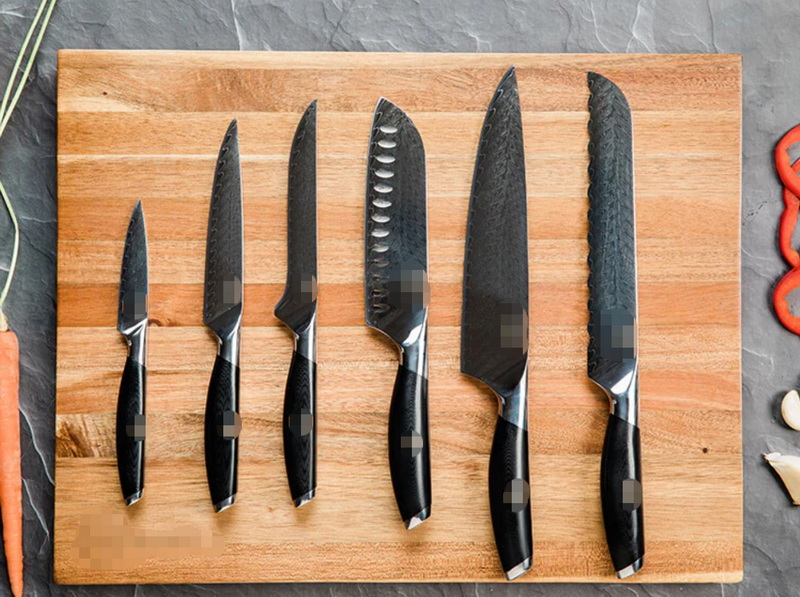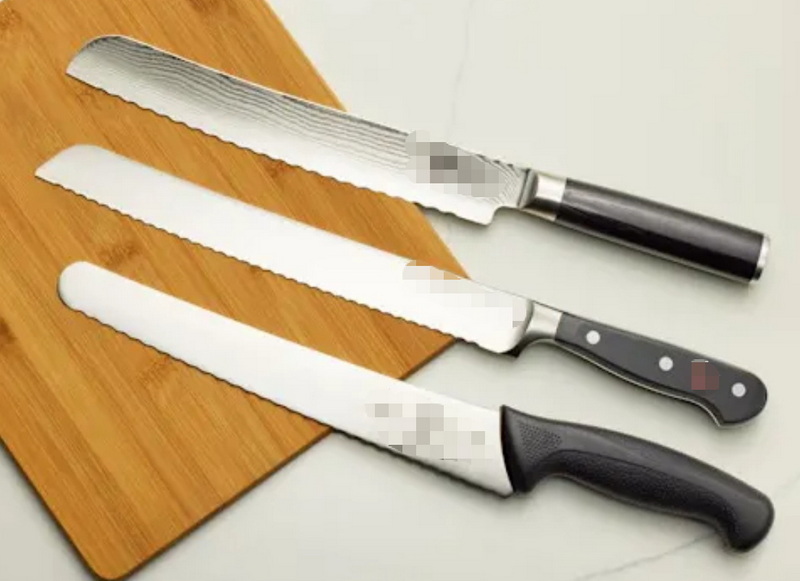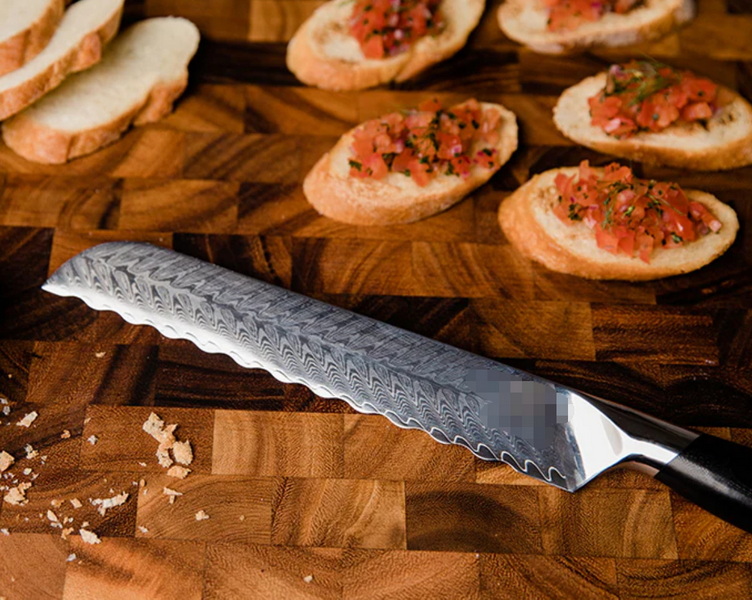- All
- Product Name
- Product Keyword
- Product Model
- Product Summary
- Product Description
- Multi Field Search
Views: 222 Author: Ann Publish Time: 2025-11-07 Origin: Site











Content Menu
● Edge Performance and Cutting Dynamics
● Materials and Manufacturing Considerations
● Usage Scenarios Across Markets
● Branding, Packaging, and SEO Considerations
● Historical Context and Evolution
● Global Market Relevance and OEM Strategy
>> What distinguishes a Bread Knife from a Chef Knife?
>> Can Bread Knife be used for tomatoes?
>> How to sharpen Bread Knife?
>> What blade length is typical?
>> Is Bread Knife good for cakes?
Bread knives occupy a distinctive niche in the spectrum of kitchen tools. Their serrated blades are purpose-built to tackle the dual challenge of crusty exteriors and soft interiors, enabling clean, even slices without crushing crumb structure or tearing delicate surfaces. This dual capability makes Bread Knife not merely a specialty tool, but a fundamental component of any serious knife lineup intended for international OEM customers who demand reliability, performance, and design versatility in branded products. In modern kitchens and professional settings, the Bread Knife's role extends beyond bread to include pastries, cakes, tomatoes, and other soft-to-medium texture foods where a straight-edged blade would struggle. This article elaborates on the unique engineering, material science, usage protocols, and market implications of the Bread Knife, while aligning with the needs of foreign brand partners seeking high-quality OEM solutions.

The bread knife is defined by a long, serrated blade that behaves like a tiny saw in culinary use. Serrations are designed to grip hard crusts and then gently saw through crumb without damaging the interior. The geometry of the teeth—sharpness, depth, tooth spacing, and scalloped versus pointed profiles—directly influences cut quality and maintenance requirements. In professional OEM programs, blade geometry can be customized to balance factors such as crust hardness, loaf size, and consumer handling preferences. Materials commonly used include German or Japanese high-carbon stainless steels with corrosion resistance and edge stability, often finished with polished or satin surfaces for branding aesthetics. One-piece construction and robust tangs improve balance and durability under repeated, high-intensity use. For brand partners, these construction choices translate into reliable performance across diverse markets and rigorous kitchen environments.
The core advantage of Bread Knife is its ability to slice through tough crusts while preserving the crumb's integrity. Serrated edges reduce the amount of downward force required and distribute cutting pressure more evenly along the blade's length. When applied to artisanal loaves, a well-designed Bread Knife produces uniform slices with minimal crumb damage, enhancing plating and serving quality. In bakery or deli contexts, the speed and consistency of slicing contribute to throughput and presentation. For tomatoes and soft fruits, the serrations create a clean, non-squashing cut that preserves skin integrity and internal texture, which is an important selling point for consumer education and product demonstrations in OEM marketing materials.
Bread Knife blades are typically manufactured from high-carbon stainless steel or forged tool steels, with attention to alloy composition to balance hardness, toughness, and corrosion resistance. Finishes range from mirror-polished to semi-matin, with some models incorporating diffusion-etched patterns for grip and branding under light. Handle design is critical for comfort during long slicing sessions. Common options include full tang, triple-rivet polypropylene, pakkawood, or polymer composites with slip-resistant textures. In OEM programs, handle shapes can be customized for ergonomic comfort, branding visibility, and hygienic performance, including dishwasher-safe coatings and colorways aligned with brand identity. The blade length typically spans 8 to 10 inches, though variants up to 12 inches are available for larger loaves, with appropriate reinforcement near the tip to resist bending.
Bread Knife serrations require different maintenance than plain-edged blades. Home users often struggle with whether to sharpen serrated edges, and traditional honing rods are less effective on serrations. Professional sharpening services or specialized serration files are recommended to restore performance without altering the tooth geometry. For OEM partners, offering maintenance guidance and value-added services—such as replacement serration guides, sharpeners, or service networks—can differentiate product lines and sustain customer satisfaction across international markets.
Bread Knife usage spans households, bakeries, and hospitality settings, but the core functionality translates well to many culinary tasks:
- Bread and bakery goods: Clean, even slices with crust retention and crumb integrity.
- Cakes and pastries: Gentle cutting that preserves delicate textures and decorations.
- Tomatoes and soft-skinned fruits: Skin puncture and clean interior slicing without crushing.
- Cheese and cured meats: Partial slicing of semi-hard textures where precise thickness matters.
From an OEM perspective, Bread Knife branding benefits from a holistic approach: ergonomic handle silhouettes, premium surface finishes, and packaging that communicates durability, hygiene, and performance. In marketing content, emphasize the Bread Knife's role in preserving crumb structure, reducing waste, and enabling consistent portioning—messages that resonate with international buyers seeking reliable kitchen tools for diverse markets. For search optimization, emphasize keywords such as Bread Knife, serrated blade, crust cutting, crumb preservation, and ergonomic handle, ensuring natural inclusion within product pages, blogs, and buyer guides.

Ergonomic considerations influence user comfort and safety:
- Handle shape and texture reduce fatigue during extended use.
- Balanced weight distribution minimizes wrist strain.
- Non-slip materials improve control on wet surfaces, which is common in bakery and food-service environments.
- Proper technique guidance reduces the risk of slips or accidental cuts.
Safety tips to accompany marketing materials can be included in manuals and on product pages to educate consumers and professional buyers.
Bread Knives have a storied history tied to the evolution of bread itself. The emergence of serrated blades is linked to innovations in cutting technology during the late 19th and early 20th centuries, with notable designs emerging from German and American knife makers. Understanding this history helps frame the Bread Knife not only as a tool but as a practical artifact of culinary evolution. For OEM partnerships, telling this story can enrich brand narratives and differentiate product lines in crowded markets.
In today's global kitchenware market, the Bread Knife serves as a bridge between functionality and brand storytelling. Key strategic considerations for OEM collaborations include:
- Customization: Tailor blade geometry, edge finish, and handle materials to meet regional preferences and regulatory requirements.
- Compliance: Ensure materials and coatings comply with food safety standards in target markets, including global certifications where applicable.
- Packaging: Develop region-specific packaging that communicates durability, hygiene, and performance while aligning with brand identity.
- After-sales support: Offer sharpening services, spare parts, and warranty programs to build trust with international customers.
Bread Knife design embodies a unique blend of geometry, material science, ergonomics, and market positioning that sets it apart from other kitchen knives. For OEM manufacturers and international brands, delivering Bread Knife solutions that combine performance with branding flexibility offers substantial value across markets where bread culture, pastry arts, and culinary craftsmanship are highly valued. By focusing on serrated edge performance, robust construction, ergonomic handles, and comprehensive after-sales support, kitchen knife manufacturers can build durable, high-margin product lines that meet diverse consumer needs worldwide.

A Bread Knife uses a long serrated blade designed to slice through crusts without crushing the crumb, whereas a Chef Knife relies on a straight edge for chopping and slicing across a broad range of ingredients.
Yes, the serrated edge yields clean, non-squashing slices on soft-skinned produce.
Serrated edges require specialized sharpening methods or professional services to preserve tooth geometry.
Common lengths range from 8 to 10 inches, with options up to 12 inches for larger loaves.
Yes, serrations help prevent tearing of delicate cake crumb while providing precise cuts.
The Ultimate Professional Knives for Halal Butchery in Middle Eastern Kitchens
Chef Knife Size Guide: Choosing Between 6″, 8″, 10″, And 12″
Custom Knife Handles: How To Design A Chef Knife That Fits Your Hand Perfectly
Chef Knife Surface Treatments Guide: From Polished Migaki To Damascus Patterns
Inside Our Professional Knife Sample Room: Quality You Can See
Universal Knife Block Buying Guide: Modern Acrylic & ABS Knife Holders for Professional Kitchens
Universal Knife Block: The Complete Guide To Modern, Hygienic Knife Storage
The Complete Guide To Red Handle Knife Sets: Style Meets Functionality in The Kitchen
Professional Knives for Halal Butchery And Middle Eastern Cuisine